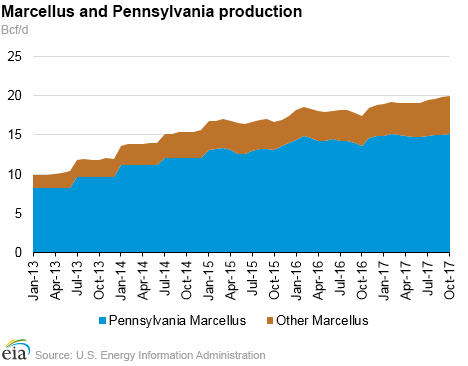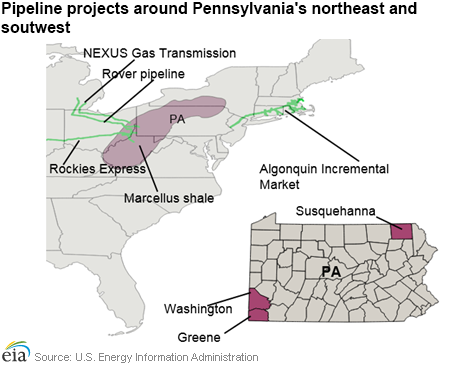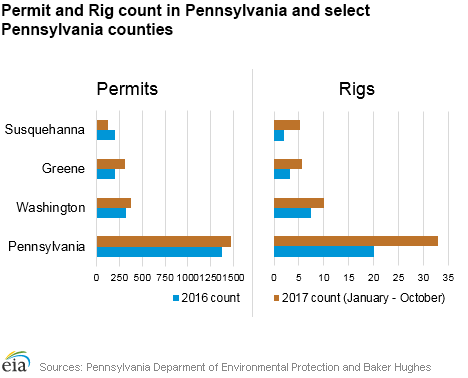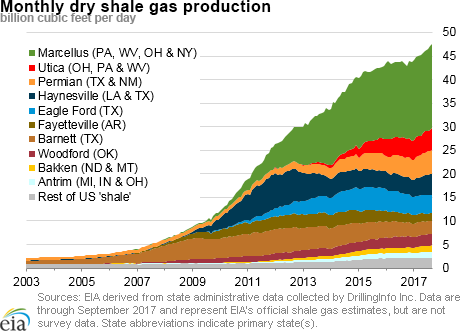In the News:
Permitting, drilling, and infrastructure activities increase as Pennsylvania’s natural gas production reaches new highs
Pennsylvania’s natural gas production reached a new high of 15 billion cubic feet per day (Bcf/d) in October 2017, an increase of 25% from year-ago levels and an increase of 80% from January 2013. Currently Pennsylvania accounts for 19% of total U.S. natural gas production. This production is largely from Appalachia’s Marcellus shale formation, 76% of which currently comes from Pennsylvania. The Marcellus formation is primarily located in Pennsylvania, West Virginia, and New York.
Pennsylvania is seeing an increase in permitting and drilling activity as new pipelines come online capable of moving natural gas to market centers outside of the region. The Pennsylvania Department of Environmental Protection issued 1,371 natural gas drilling permits in 2016, but so far in 2017 it has already issued 1,447 permits. During 2016, the daily rig count averaged 20 rigs in Pennsylvania. So far in 2017, the average daily rig count in Pennsylvania is 33 rigs, based on data from Baker Hughes.
Permitting and drilling activity in Pennsylvania is concentrated in a few counties with the state’s most productive wells. Of the three counties with the largest number of permits and rig counts, two of them—Washington and Greene—are in the southwest region of the state. Susquehanna County in the northeast has the third-highest number of permits and rigs. In 2016 and 2017, these three counties combined accounted for slightly more than half of the total permits and two-thirds of the rig operating in Pennsylvania.
Pipeline projects are being developed close to Pennsylvania’s southwest and northeast regions to carry natural gas from these counties to demand centers. Current pipeline projects include the 3.25 Bcf/d Rover Pipeline Project and the 1.5 Bcf/d Nexus Gas Transmission Project, both slated to begin operations during the first quarter of 2018. Last year, completed projects include the Rockies Express Zone 3 expansion, which entered into service in January 2017, to increase the capacity to move natural gas westward out of southwest Pennsylvania and the Algonquin Incremental Market pipeline, which entered into service in December 2016, primarily to move natural gas from northeastern Pennsylvania into New England.
Overview:
(For the Week Ending Wednesday, November 1, 2017)
- Natural gas spot prices fell at most locations this report week (Wednesday, October 25 to Wednesday, November 1). The Henry Hub spot price fell from $2.93 per million British thermal units (MMBtu) last Wednesday to $2.64/MMBtu yesterday.
- At the New York Mercantile Exchange (Nymex), the November 2017 contract expired Friday at $2.752/MMBtu. The December 2017 contract price decreased to $2.893/MMBtu, down 19¢ Wednesday to Wednesday.
- Net injections to working gas totaled 65 billion cubic feet (Bcf) for the week ending October 27. Working natural gas stocks are 3,775 Bcf, which is 5% less than the year-ago level and 1% less than the five-year (2012–16) average for this week.
- The natural gas plant liquids composite price at Mont Belvieu, Texas, rose by 33¢, averaging $8.28/MMBtu for the week ending November 1. The price of natural gasoline, ethane, propane, butane, and isobutane all rose, by 6%, 3%, 6%, 1%, and 1%, respectively.
- According to Baker Hughes, for the week ending Friday, October 27, the natural gas rig count decreased by 5 to 172. The number of oil-directed rigs rose by 1 to 737. The total rig count decreased by 4, and it now stands at 909.
Prices/Supply/Demand:
Wednesday-to-Wednesday prices fall at most locations, while weekly average prices generally increased with colder temperatures across the Lower 48. This report week (Wednesday, October 25 to Wednesday, November 1), the Henry Hub spot price fell 29¢ from $2.93/MMBtu last Wednesday to $2.64/MMBtu yesterday, while the weekly average price decreased 3¢, from $2.84/MMBtu last report week to $2.81/MMBtu this report week. Temperatures across the Lower 48 averaged 4°F higher than NOAA’s 30-year normal last report week but averaged 2°F lower than normal this report week.
At the Chicago Citygate, prices decreased 34¢ from $3.01/MMBtu last Wednesday to $2.67/MMBtu yesterday, while the weekly average price increased by 7¢, from $2.80/MMBtu to $2.87/MMBtu. Temperatures in Illinois averaged 57°F over last report week and decreased 16°F to 41°F this report week.
Northeast price movements are mixed. At the Algonquin Citygate, which serves Boston-area consumers, prices dropped by $2.05 from $3.23/MMBtu last Wednesday to $1.18/MMBtu yesterday, but the weekly average price decreased by 13¢, from $2.79/MMBtu last report week to $2.66/MMBtu this report week. Temperatures in Massachusetts have been averaging well above normal over the last report week and this report week.
At the Transcontinental Pipeline Zone 6 trading point for New York, prices decreased $1.59 from $2.93/MMBtu last Wednesday to $1.34/MMBtu yesterday, and weekly average prices increased 6¢, from $2.37/MMBtu last report week to $2.43/MMBtu this report week. Temperatures in New York averaged 8°F higher than normal for last report week and were just 3°F higher than normal—or 51°F—this report week.
California prices decrease. The price at SoCal Citygate decreased 94¢ from $4.17/MMBtu last Wednesday to $3.23/MMBtu yesterday, and the weekly average price decreased $2.05/MMBtu, from $5.35/MMBtu last report week to $3.30/MMBtu this report week. SoCal Citygate prices last week far exceeded historical records with supply constraints and record high temperatures. Coastal Southern California temperatures were more than 10°F higher than normal for the last four days of last report week but have continued to decrease over this report week, ending the week 4°F lower than normal yesterday. Prices at PG&E Citygate in Northern California fell 24¢, down from $3.19/MMBtu last Wednesday to $2.95/MMBtu yesterday, while the weekly average price decreased 10¢, from $3.18/MMBtu last report week to $3.08/MMBtu this report week.
Appalachian weekly average prices increase. Tennessee Zone 4 Marcellus spot prices decreased 28¢ from $0.80/MMBtu last Wednesday to $0.52/MMBtu yesterday, but weekly average prices increased 9¢, from $0.63/MMBtu last report week to $0.72/MMBtu this report week. Prices at the Dominion South hub in northwest Pennsylvania fell 56¢ from $1.23/MMBtu last Wednesday to $0.67/MMBtu yesterday; however, weekly average prices increased 30¢, from $0.79/MMBtu last report week to $1.09/MMBtu this report week. According to pipeline project data from PointLogic, at least two Appalachian pipeline projects—Access South and Adair Southwest—were put into partial service this report week, increasing the takeaway capacity from the Appalachian production region. Both projects involve new construction and modification of existing facilities, e.g., pipeline reversals, to move natural gas from the Appalachian production region to market.
Supply mostly increases. According to data from PointLogic Energy, the average total supply of natural gas rose by 1% compared with the previous week. Dry natural gas production grew by 1% compared with the previous report week. Net imports from Canada remained the same as last week, averaging 5.8 billion cubic feet per day (Bcf/d).
Overall demand increases largely because of increased residential consumption and colder temperatures. Total U.S. consumption of natural gas rose by 14% compared with the previous report week, according to data from PointLogic Energy. Natural gas consumed for power generation declined by 8% week over week. Industrial sector consumption increased by 5% week over week. In the residential and commercial sectors, consumption increased by 73% as the weekly average U.S. temperature decreased 9°F, from 60°F last report week to 51°F this report week. Natural gas exports to Mexico decreased 2%.
U.S. LNG exports were flat week-over-week. Six LNG vessels (LNG-carrying capacity 22.4 Bcf) departed Sabine Pass liquefaction facility last week (Thursday to Wednesday). With substantial completion of Train 4 at Sabine Pass, all four trains at the facility have been running above the nameplate capacity for the past three weeks. A record 22 cargoes were exported from Sabine Pass in October, exceeding the previous record set in May 2017 with 18 exported cargoes.
Puerto Rico has resumed LNG imports, receiving first LNG cargo since September 8, after the Hurricane Maria struck the island in September, according to shipping data compiled by Bloomberg.
Storage:
Weekly net injections exceed the five-year average. Net injections into storage totaled 65 Bcf, compared with the five-year (2012–16) average net injection of 60 Bcf and last year's net injections of 56 Bcf during the same week. Net injections into storage exceed the five-year average in the East and Midwest regions. The Pacific and South Central regions were 2 and 1 Bcf lower than the five-year average, respectively. Working gas stocks total 3,775 Bcf, which is 41 Bcf less than the five-year average and 180 Bcf less than last year at this time.
Working gas stocks appear likely to end the refill season lower than the five-year average. So far during the 2017 refill season, net injections into storage are 16% lower than the comparable five-year average—a 1,724 Bcf increase during the 2017 refill season compared with the five-year average increase of 2,030 Bcf. If net injections follow the five-year average for the remaining week of the injection season, working gas stocks will reach 3,782 Bcf by the end of the refill season. This level would be the lowest level reported at the end of October since 2014, when working gas stocks totaled 3,564 Bcf. In practice, injections into working gas typically continue for a couple of weeks into November—after the official beginning of the heating season. As a result, working gas stocks could reach 3,831 Bcf by November 10 if net injections match the five-year average over the next two weeks.
The January 2018 futures price trades at a discount compared with the current spot price. During the most recent storage week, the average natural gas spot price at the Henry Hub was $2.89/MMBtu, while the Nymex futures price of natural gas for delivery in January 2018 averaged $3.23/MMBtu, a difference of 34¢/MMBtu. The premium was 60¢/MMBtu a year ago. The average natural gas spot price at the Henry Hub was 5¢/MMBtu lower than the front-month futures price at the Nymex.
The reported net implied flows into storage are quite close to analysts’ expectations. According to the Desk survey of natural gas analysts, estimates of net injections into working natural gas storage ranged from 52 Bcf to 71 Bcf with a median of 64 Bcf. Trading on the Nymex was uncharacteristically light following the release of the Weekly Natural Gas Storage Report. The price of the contract for December delivery at the Henry Hub was essentially unchanged averaging $2.93/MMBtu, with only 13 trades executed at the release. Prices rose somewhat in subsequent trading, averaging roughly $2.94/MMBtu.
Temperatures decline on the week and remain higher than normal in most regions. Temperatures in the Lower 48 states averaged 59 degrees Fahrenheit (°F), 5°F higher than the normal and the same as last year at this time. During the prior report week ending October 12, temperatures averaged 61°F.
See also:
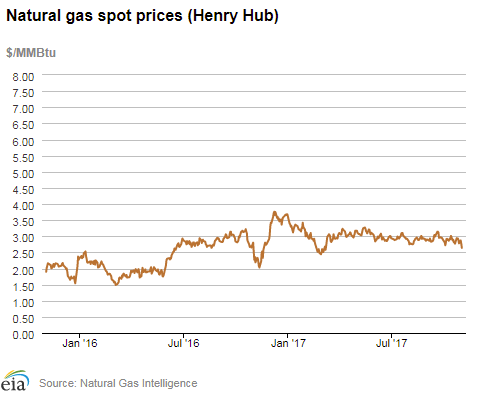
| Spot Prices ($/MMBtu) | Thu, 26-Oct |
Fri, 27-Oct |
Mon, 30-Oct |
Tue, 31-Oct |
Wed, 1-Nov |
|---|---|---|---|---|---|
| Henry Hub | 2.89 |
2.78 |
2.87 |
2.77 |
2.64 |
| New York | 2.71 |
2.29 |
2.94 |
2.64 |
1.34 |
| Chicago | 2.93 |
2.85 |
3.05 |
2.78 |
2.67 |
| Cal. Comp. Avg.* | 3.01 |
2.74 |
2.91 |
2.81 |
2.71 |
| Futures ($/MMBtu) | |||||
| November Contract | 2.890 |
2.752 |
Closed |
Closed |
Closed |
| December Contract | 3.051 |
2.964 |
2.966 |
2.896 |
2.893 |
| January Contract | 3.175 |
3.102 |
3.100 |
3.026 |
3.017 |
| *Avg. of NGI's reported prices for: Malin, PG&E Citygate, and Southern California Border Avg. | |||||
| Source: NGI's Daily Gas Price Index | |||||
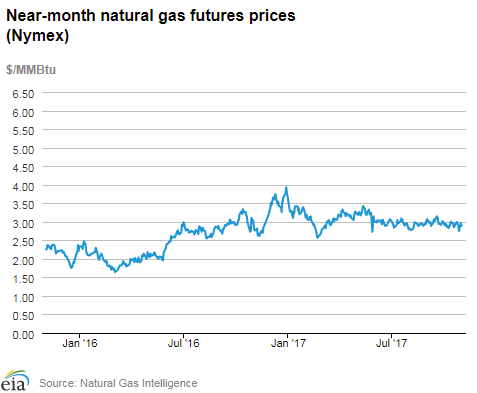
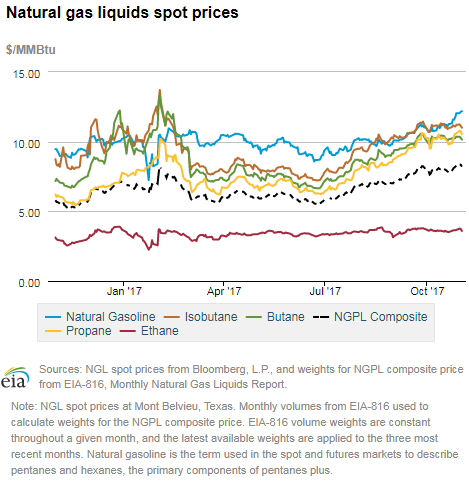
| U.S. natural gas supply - Gas Week: (10/26/17 - 11/1/17) | |||
|---|---|---|---|
Average daily values (Bcf/d): |
|||
this week |
last week |
last year |
|
| Marketed production | 84.2 |
83.2 |
79.4 |
| Dry production | 75.5 |
74.6 |
70.8 |
| Net Canada imports | 5.8 |
5.8 |
6.2 |
| LNG pipeline deliveries | 0.1 |
0.0 |
0.2 |
| Total supply | 81.4 |
80.4 |
77.2 |
|
Source: OPIS PointLogic Energy, an IHS Company | |||
| U.S. natural gas consumption - Gas Week: (10/26/17 - 11/1/17) | |||
|---|---|---|---|
Average daily values (Bcf/d): |
|||
this week |
last week |
last year |
|
| U.S. consumption | 64.5 |
56.4 |
60.1 |
| Power | 21.9 |
23.8 |
24.0 |
| Industrial | 21.1 |
20.1 |
20.2 |
| Residential/commercial | 21.5 |
12.4 |
15.9 |
| Mexico exports | 4.2 |
4.2 |
4.3 |
| Pipeline fuel use/losses | 6.9 |
6.2 |
6.6 |
| LNG pipeline receipts | 2.8 |
3.0 |
0.9 |
| Total demand | 78.5 |
69.8 |
71.8 |
|
Source: OPIS PointLogic Energy, an IHS Company | |||
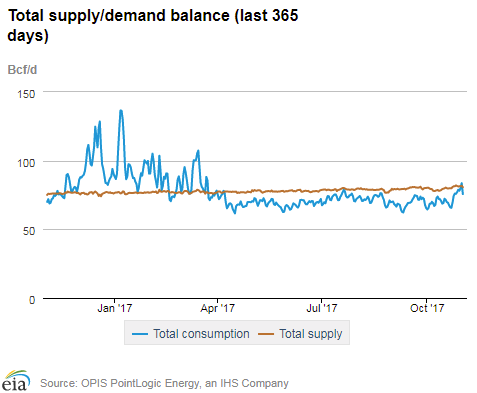
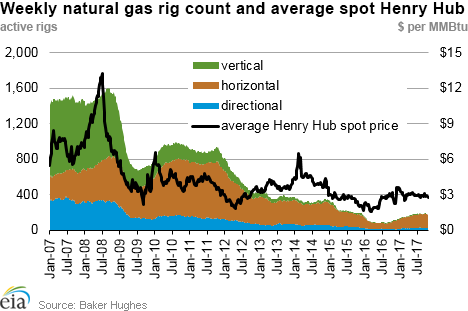
| Rigs | |||
|---|---|---|---|
Fri, October 27, 2017 |
Change from |
||
last week |
last year |
||
| Oil rigs | 737 |
0.1% |
67.1% |
| Natural gas rigs | 172 |
-2.8% |
50.9% |
| Note: Excludes any miscellaneous rigs | |||
| Rig numbers by type | |||
|---|---|---|---|
Fri, October 27, 2017 |
Change from |
||
last week |
last year |
||
| Vertical | 66 |
6.5% |
24.5% |
| Horizontal | 769 |
-0.3% |
70.9% |
| Directional | 74 |
-7.5% |
37.0% |
| Source: Baker Hughes Inc. | |||
| Working gas in underground storage | ||||
|---|---|---|---|---|
Stocks billion cubic feet (Bcf) |
||||
| Region | 2017-10-27 |
2017-10-20 |
change |
|
| East | 926 |
915 |
11 |
|
| Midwest | 1,107 |
1,082 |
25 |
|
| Mountain | 226 |
224 |
2 |
|
| Pacific | 317 |
315 |
2 |
|
| South Central | 1,199 |
1,174 |
25 |
|
| Total | 3,775 |
3,710 |
65 |
|
| Source: U.S. Energy Information Administration | ||||
| Working gas in underground storage | |||||
|---|---|---|---|---|---|
Historical comparisons |
|||||
Year ago (10/27/16) |
5-year average (2012-2016) |
||||
| Region | Stocks (Bcf) |
% change |
Stocks (Bcf) |
% change |
|
| East | 940 |
-1.5 |
921 |
0.5 |
|
| Midwest | 1,128 |
-1.9 |
1,084 |
2.1 |
|
| Mountain | 248 |
-8.9 |
218 |
3.7 |
|
| Pacific | 326 |
-2.8 |
360 |
-11.9 |
|
| South Central | 1,313 |
-8.7 |
1,234 |
-2.8 |
|
| Total | 3,955 |
-4.6 |
3,816 |
-1.1 |
|
| Source: U.S. Energy Information Administration | |||||
| Temperature – heating & cooling degree days (week ending Oct 26) | ||||||||
|---|---|---|---|---|---|---|---|---|
HDD deviation from: |
CDD deviation from: |
|||||||
| Region | HDD Current |
normal |
last year |
CDD Current |
normal |
last year |
||
| New England | 37 |
-79 |
-33 |
0 |
0 |
-3 |
||
| Middle Atlantic | 46 |
-60 |
-21 |
0 |
0 |
-5 |
||
| E N Central | 78 |
-37 |
-18 |
0 |
-1 |
-1 |
||
| W N Central | 77 |
-38 |
-19 |
0 |
-1 |
0 |
||
| South Atlantic | 42 |
-20 |
6 |
25 |
4 |
-4 |
||
| E S Central | 52 |
-10 |
13 |
3 |
-3 |
-14 |
||
| W S Central | 24 |
-4 |
6 |
27 |
6 |
-10 |
||
| Mountain | 85 |
-24 |
12 |
14 |
8 |
-3 |
||
| Pacific | 25 |
-20 |
7 |
24 |
20 |
17 |
||
| United States | 53 |
-32 |
-6 |
13 |
5 |
-1 |
||
|
Note: HDD = heating degree day; CDD = cooling degree day Source: National Oceanic and Atmospheric Administration | ||||||||
Average temperature (°F)
7-Day Mean ending Oct 26, 2017
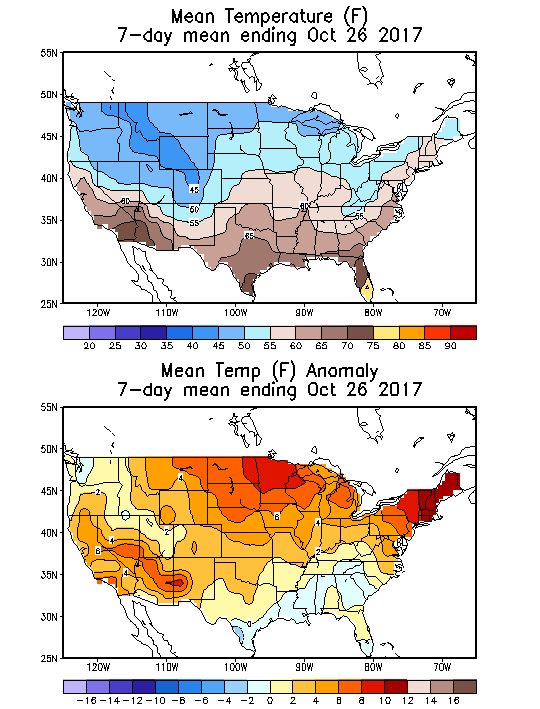
Source: NOAA National Weather Service
Deviation between average and normal (°F)
7-Day Mean ending Oct 26, 2017

Source: NOAA National Weather Service

